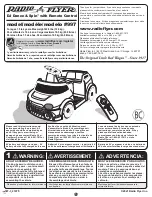
SLASH VXL • 19
Water resistance applies only to the installed electronic components.
Running in wet conditions requires additional care and maintenance
for the mechanical and electrical components to prevent corrosion
of metal parts and maintain their proper function.
Precautions
• Without proper care, some parts of your model can be seriously
damaged due to contact with water. Know that additional
maintenance procedures will be required after running in wet
conditions in order to maintain the performance of your model.
Do not run your model in wet conditions if you are not willing to
accept the additional care and maintenance responsibilities.
•
Not all batteries can be used in wet environments.
Consult your
battery manufacturer to see if their batteries can be used in wet
conditions. Do not use LiPo batteries in wet conditions.
• The Traxxas TQi transmitter is not water resistant. Do not subject it
to wet conditions such as rain.
• Do not operate your model during a rain storm or other inclement
weather where lightning may be present.
• Do NOT allow your model to come in contact with salt water
(ocean water), brackish water (between fresh water and ocean
water), or other contaminated water. Salt water is highly
conductive and highly corrosive. Use caution if you plan to run
your model on or near a beach.
Before Running Your Vehicle in Wet Conditions
1. Consult the section “After Running Your Vehicle in Wet
Conditions” before proceeding. Make sure you understand the
additional maintenance required with wet running.
2. The wheels have small holes molded in to allow air to enter and
exit the tire during normal running. Water will enter these holes
and get trapped inside the tires if holes are not cut in the tires. Cut
two small holes (3mm or 1/8” diameter) in each tire. Each hole
should be near the tire center-line, 180 degrees apart.
3. Confirm that the receiver box O-ring and cover are installed
correctly and secure. Make sure the screws are tight and the blue
O-ring is not visible protruding from the edge of the cover.
4. Confirm that your batteries can be used in wet conditions.
5. Use lower gearing (smaller pinion gears, as low as 16T or spur
gear as large as 90T) when running in mud, deep puddles, snow,
or other similar situations that will restrict the tires and put much
higher loads on the motor.
Motor Precautions
• Velineon motor life can be greatly reduced in mud and water. If the
motor gets excessively wet or submerged, use very light throttle
(run the motor slowly) until the excess water can run out. Applying
full throttle to a motor full of water can cause rapid motor failure.
Your driving habits will determine motor life with a wet motor. Do
not submerge the motor under water.
• Do not gear the motor by temperature when running in wet
conditions. The motor will be cooled by water contact and will not
give an accurate indication of appropriate gearing.
• Use special care when operating your model in muddy conditions.
Stop operating your model if it appears to be straining due to the
tackiness of the mud, or build-up of mud on the chassis. Do not allow
mud to collect on the motor or pack around the motor.
After Running Your Vehicle in Wet Conditions
1. Drain the tires by spinning the tires at high speed to “sling” the
water out. One way to do this is to make several high-speed passes
on a flat, dry surface, if possible. This will only work with holes cut in
the tires, see step 2 of Before Running Your Vehicle in Wet Conditions.
2. Remove the batteries.
3. Rinse excess dirt and mud off the truck with low-pressure water,
such as from a garden hose. Do NOT use pressure washer or other
high-pressure water. Avoid directing water into the bearings,
differentials, etc.
4. Blow off the truck with compressed air (optional, but
recommended). Wear safety glasses when using compressed air.
5. Remove the wheels from the truck.
6. Spray all the bearings, drivetrain, and fasteners with WD-40
®
or
similar water displacing light oil.
7. Let the truck stand or you may blow it off with compressed air.
Placing the truck in a warm sunny spot will aid drying. Trapped water
and oil will continue to drip from the truck for a few hours. Place it
on a towel or piece of cardboard to protect the surface underneath.
8. As a precautionary step, remove the sealed receiver box
cover. While unlikely, humidity or tiny amounts of moisture or
condensation may enter the receiver box during wet running. This
can cause long-term problems with the sensitive electronics in the
receiver. Removing the receiver box cover during storage allows
the air inside to dry. This step can improve the long-term reliability
of the receiver. It is not necessary to remove the receiver or unplug
any of the wires.
DRIVING YOUR MODEL














































